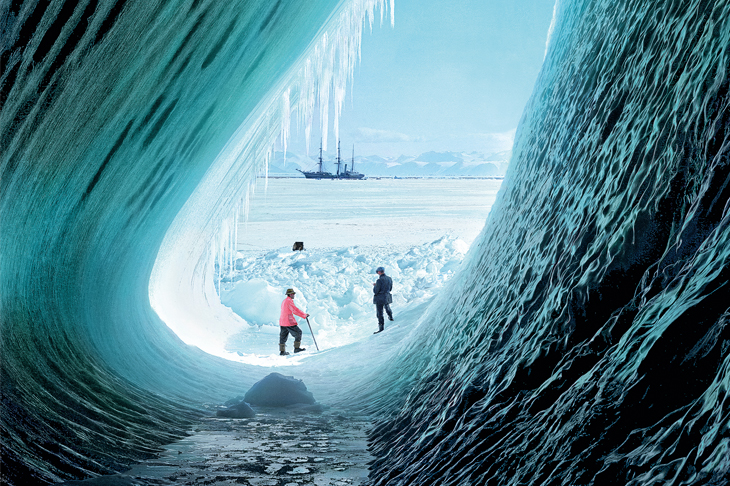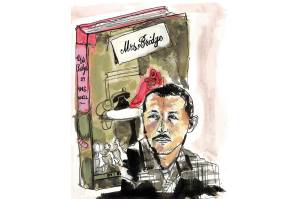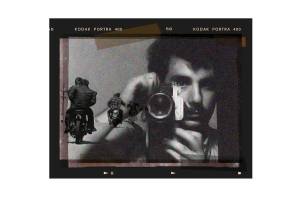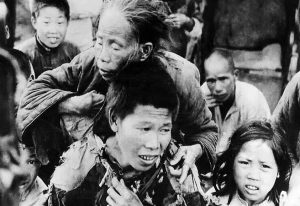There is something of The Wizard of Oz about Marina Amaral’s photographs. She whisks us from black-and-white Kansas to shimmering Technicolor Oz. When Howard Carter leans over Tutankhamun’s open sarcophagus (1922), he does so in the glare of pharaonic gold. A photograph of fallen American soldiers on the Gettysburg battlefield (1863) shocks the more when we see the colour of the blood soaking through shirts. The Javanese dancers who performed at the Exposition Universelle in Paris (1889) are gorgeous in madder pinks, jades and golds. I’ve seen this picture a dozen times, rolled out to illustrate the influence of ‘exotic’ dancers on artists and choreographers, but I’d never considered that what attracted Rodin and Degas wasn’t just movement and form but colour, glorious colour.
‘My goal,’ says 23-year-old Amaral, ‘is not to replace black-and-white photographs or to do something better than the original photographer. What I try to do is to build a bridge between the present and the past.’ She talks of a failing in the way our minds work. ‘One side of the brain, when we look at a black-and-white photo, understands that the past was as colourful and vivid as our present. But the other side of the brain can’t feel the “essence” of this when we look at the photo.’ No matter how many times you read that Mata Hari was the arch-seductress, the slinkiest, sultriest dancer of the belle époque, you look at black-and-white portraits of Mademoiselle Mata in jewelled, cuffed and gauzed costume and think: how quaint. Worse: she’d have been about my great-great-great-grandmother’s age. When you see Amaral’s coloured portrait, you think: phwoar!
Two hundred of Amaral’s photographs illustrate The Colour of Time: A New History of the World 1850–1960. Dan Jones’s words do the business, but it is Amaral’s photographs that awe. She changes the way we see a period or a person. Here is Queen Victoria, not an ‘old lady’ in black widow’s weeds, but a young woman in sprigged muslin. ‘She was not always the person we have in mind,’ says Amaral. Nor were the Victorians always dour and mournful.
On Twitter, where Amaral posts her colourised photographs alongside potted histories, she is a crusader for the truth. Fake news bothers her. Fake pics are rife. She calls out the cheats. A widely retweeted photograph of Marie Curie? Looking pensively pretty as she discovers radium? #scienceissexy? A fraud. Posed by a model. That’s the Hollywood-biopic Curie. The real one, frowning, frumpy, frizzy-haired in the lab, can be seen on p192 of Amaral’s book.
Amaral reacted swiftly to doctored photographs of Thomas Edison wearing a crinolined dress, used to illustrate an article on prejudice against homosexuals in the 1880s. Other stern-looking male contemporaries had been photoshopped into frocks and corsets. Readers were duped into thinking that cross-dressing and gender-queering for the camera was as common as ‘Watch the birdie!’ Not so drab, not so buttoned up as we thought, eh? The images were shared and retweeted as gospel.
‘It’s very easy,’ says Amaral on a Skype call from Belo Horizonte, Brazil, where she works long, square-eyed hours at her MacBook, ‘to accept those images as actual photographs. I was really intrigued by the way the photo was used. People had no idea who that face [Edison] was. They couldn’t find any clue that the photograph had been changed or manipulated.
‘When we colourise a photograph, we are not changing the context. We are not introducing elements that were not part of the original photograph. We are just adding colour over the objects that are already part of it. We are not changing the story. But when you change, or introduce, or remove elements you change what a photograph means. And that is very dangerous.’
Amaral wonders if clue-hunting could be taught in school history lessons. ‘We need to understand that we cannot portray the truth to our own convenience. We need to stick to the truth no matter what. If we start teaching children from the beginning that this is a moral issue, then maybe things will change.’
Amaral’s mother is a historian, a specialist in Brazilian studies. Fact-checking and attention to evidence were learnt in the cradle. ‘I have loved history ever since I understood what love is.’
Amaral is as rigorous in her method as she is in her colourist’s code of conduct. ‘It’s not a hobby,’ she says. ‘It’s not as simple as picking up a big bunch of crayons and applying random colours over an image. Before I even start to colourise, I do an in-depth investigation of all the elements of a photo, because I want, I need to identify as many of the original colours as I can.’ When it came to the photograph of nine kings taken at Windsor in May 1910 after the death of Edward VII, Amaral spent days interviewing royal and military historians to identify each medal, each fringe and button of the uniforms, the paintings on the walls, the carpet and the jewels. ‘What separates the good colourist from the bad one,’ says Amaral, ‘is not technique but their respect for history.’
The application of colour may be done in Photoshop, but Amaral still ‘paints’ by hand. ‘There are no shortcuts.’ Using a stylus she blends colours, sometimes hundreds of layers thick, spending hours, even days on every detail. She describes the complete mental exhaustion that follows each finished image.
Her greatest challenge was the photograph taken at Buchenwald concentration camp after liberation. ‘It is so striking, so powerful. I had to choose colours that would reproduce the skin of people who were subjected to the most horrific conditions for years. They were sick, some almost on the verge of death. I had to look into the faces of every man in the photo. It was difficult technically — and emotionally.’ The result is haunting.
You might ask: does it make a difference? Yes. When it comes to the Eiffel Tower it doesn’t much matter if the struts are red as they were when first built, or the black of contemporary photographs, or the rusty grey of today. But in any portrait of a real person whether it’s Garibaldi, the Last Empress of China, or a mother and baby displaced by the Herero Wars in what is now Namibia, the difference made by colour is startling. Amaral breathes life into these named and unknown figures. They become immediate and vital. No longer an ancestor in an archive or a daguerreotype to blow the dust off, but someone you passed on the bus that morning. ‘We are a hundred years apart,’ says Amaral. ‘But we are the same.’


















